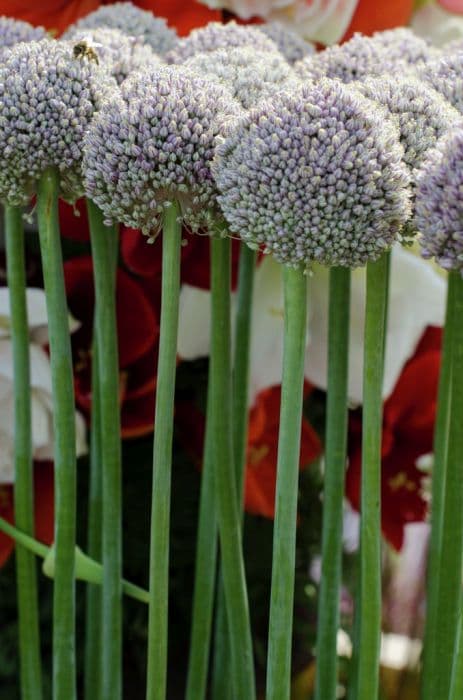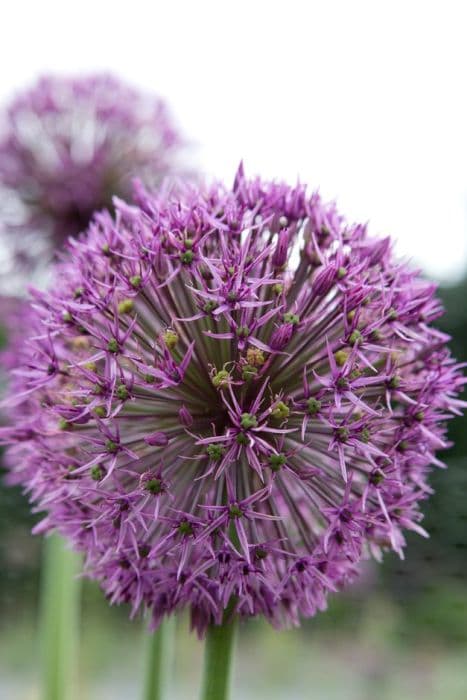Wild Garlic Allium vineale 'Dready'

ABOUT
Allium vineale 'Dready', commonly known as Wild Garlic 'Dready', is a distinctive perennial plant. Notable for its unique flowering structure, it features tight clusters of flowers and bulbils, which give the impression of a crowded, messy head often resembling dreadlocks. The flowers are generally small and star-shaped, ranging in color from green to pink or purple, often mixed within the same cluster, producing a curious and eye-catching effect. The foliage of Wild Garlic 'Dready' is grass-like, displaying thin, strap-shaped leaves that sprout from the base of the plant. These leaves are typically a vibrant green color, and when crushed, they exude a strong garlic scent, which is characteristic of the species. Indeed, it is this odor that makes the plant easily identifiable even when not in bloom. As for the stem, it is tall and erect, with a round cross-section, providing a vertical structure that supports the whimsical top-knot of flowers and bulbils. The overall form of the plant is upright and somewhat bulbous at the flowering end, which creates a focal point that draws attention in a garden setting. Wild Garlic 'Dready' produces a distinctive seed head that persists on the plant well after the blooming period, adding to its visual interest throughout the growing season. Despite its ornamental features, it's worth noting that Wild Garlic can be quite vigorous and may spread if not managed, indicating its ability to thrive under a variety of conditions. The aesthetic appeal of Wild Garlic 'Dready', combined with its resilience, makes it a unique addition to gardens, especially those that aim to have a natural or wild look.
About this plant
 Names
NamesFamily
Amaryllidaceae
Synonyms
Wild Garlic, Crow Garlic, Field Garlic, Scallion, Wild Onion
Common names
Allium vineale.
 Toxicity
ToxicityTo humans
Wild garlic is generally considered not toxic to humans and is actually sometimes used as a culinary herb. However, as with any plant, individual allergies or sensitivities could possibly occur, and consuming large amounts of this plant could potentially cause digestive discomfort due to its strong garlic-like flavor and compounds like allicin. There is not typically a risk of serious poisoning from ingesting wild garlic for humans.
To pets
Wild garlic can be toxic to pets, especially cats and dogs. The compound thiosulfate, which is found in wild garlic, can cause oxidative damage to red blood cells leading to hemolytic anemia. Signs of poisoning may include lethargy, vomiting, diarrhea, abdominal pain, and in severe cases, difficulty breathing, and an increased heart rate. If you suspect your pet has ingested wild garlic, contact a veterinarian immediately.
 Characteristics
CharacteristicsLife cycle
Perennials
Foliage type
Deciduous
Color of leaves
Green
Flower color
Varies
Height
1-2 feet (30-60 cm)
Spread
0.5-1 foot (15-30 cm)
Plant type
Bulb
Hardiness zones
5
Native area
Europe
Benefits
 General Benefits
General Benefits- Low Maintenance: This plant requires minimal care once established, making it suitable for low-maintenance gardens.
- Attracts Wildlife: Wild garlic can attract pollinators such as bees to the garden, which are beneficial for the pollination of other plants.
- Drought Tolerance: It is relatively drought-tolerant, making it suitable for xeriscaping or regions with water restrictions.
- Edible Uses: The leaves, bulb, and bulbils are edible and can be used in cooking for flavoring, much like traditional garlic.
- Ornamental: With its distinctive appearance, wild garlic adds visual interest to the garden, particularly with its globe-like flower clusters.
- Soil Improvement: Wild garlic can help to improve soil quality and structure as it breaks down in the soil after it dies back.
- Naturalizing: It has the ability to naturalize by self-seeding, filling in spaces and creating a continuous cover, which can reduce soil erosion.
 Medical Properties
Medical PropertiesThis plant is not used for medical purposes.
 Air-purifying Qualities
Air-purifying QualitiesThis plant is not specifically known for air purifying qualities.
 Other Uses
Other Uses- Allium vineale 'Dready', commonly known as wild garlic, can be used in floral arrangements due to its unique ball-like clusters of flowers which add an unconventional aesthetic.
- The dried flower heads of wild garlic can be incorporated into craft projects, such as making natural wreaths or decorative displays.
- The seeds of wild garlic can be collected and used to create natural dyes for textiles, providing a range of colors depending on the mordant used.
- Wild garlic can be used as a companion plant in the garden to repel certain pests, such as aphids, due to its strong scent.
- Its fibrous stems have been traditionally used as twine or cordage in survival situations or for educational nature craft activities.
- The plant's strong aroma can be used to mask other less pleasant smells in outdoor areas where odor control is desired.
- In permaculture, wild garlic can be used as a ground cover to prevent soil erosion and to maintain soil moisture.
- Farmers sometimes use wild garlic as a forage crop for livestock, though care must be taken due to potential tainting of milk when cows consume it.
- It can be utilized in natural pest control remedies, as when crushed, its juice can be mixed with water and sprayed to deter certain insects.
- The hollow stems of wild garlic are sometimes used in creating small nature-inspired wind instruments or whistles for educational purposes.
Interesting Facts
 Feng Shui
Feng ShuiThe Wild Garlic is not used in Feng Shui practice.
 Zodiac Sign Compitability
Zodiac Sign CompitabilityThe Wild Garlic is not used in astrology practice.
 Plant Symbolism
Plant Symbolism- Protection: Allium vineale, commonly known as "wild garlic," is often associated with protection due to its pungent aroma, which is believed to ward off evil spirits and negative energies.
- Purity: Its clean, strong scent and the fact that it can grow in less hospitable conditions often represent cleanliness and purity, suggesting an untouched or untainted aspect.
- Health and Healing: Traditionally, alliums have been used for their medicinal properties, symbolizing health and healing.
- Perseverance: The plant's ability to survive and propagate in various environments symbolizes durability and perseverance.
 Water
WaterWater your wild garlic (Allium vineale 'Dready') deeply, ensuring the water reaches the roots, once every week during its active growth in spring and summer. During the cooler months, reduce the frequency to every two weeks or when the soil feels dry to the touch, as the plant's water requirements decrease. Aim to provide about 1 gallon per plant for each watering session to keep the soil moist but not waterlogged. It's vital to avoid overwatering, which can lead to root rot. Always check the top inch of soil for dryness before watering again.
 Light
LightWild garlic prefers full sun to partial shade, thriving best under direct sunlight for at least 6 hours a day. Place it in a spot where it can benefit from the morning sun, which is usually less intense than the afternoon sun. However, in extremely hot climates, protection from the harsh afternoon sun with partial shade is beneficial to prevent scalding.
 Temperature
TemperatureWild garlic is hardy and can tolerate a range of temperatures, from as low as 0°F to as high as 90°F, making it suitable for many climates. The ideal temperature range for optimal growth is between 50°F and 75°F. Extreme temperatures outside of this range might slow down its growth or cause damage to the plant.
 Pruning
PruningPruning wild garlic generally involves removing spent flower heads to prevent self-seeding and encourage more blooms the following season. You should also trim back any yellowing or dead foliage as needed to keep the plant looking tidy. The best time to prune is right after flowering in the early summer. Prune it down to its base annually in late fall or early winter to prepare the plant for the next growing season.
 Cleaning
CleaningAs needed
 Soil
SoilWild garlic prefers well-drained soil rich in organic matter with a pH between 6.0 and 7.0. A mix of garden soil, compost, and sand in equal parts can create an ideal soil environment. Ensure good drainage to prevent waterlogging, which can lead to root rot.
 Repotting
RepottingWild garlic, or crow garlic, should generally be repotted every two to three years to refresh the soil and provide space for growing bulbs. Choose a slightly larger pot each time to accommodate growth.
 Humidity & Misting
Humidity & MistingWild garlic, also known as crow garlic, prefers moderate humidity levels but is relatively adaptable and can tolerate the humidity levels typically found in most homes and gardens.
 Suitable locations
Suitable locationsIndoor
Ensure bright light, well-draining soil, and infrequent watering for indoor crow garlic.
Outdoor
Plant in sunny spot, well-draining soil, and water moderately for outdoor crow garlic.
Hardiness zone
Wild garlic is hardy in USDA zones 4-9.
 Life cycle
Life cycleAllium vineale 'Dready', commonly known as Wild Garlic or Crow Garlic, begins its life cycle as a seed, which germinates in the soil when conditions are favorable, usually in cool spring weather. The seedlings emerge, developing thin grass-like leaves that grow in clumps and use photosynthesis to fuel the plant's growth. As the plant matures, it forms a bulb underground that stores energy for the next season. During the summer, the plant sends up a flowering stalk with a distinctive head that may contain small bulbils along with flowers; these can reproduce asexually by detaching and planting themselves or sexually through pollination, producing seeds. After flowering, the plant's aerial parts die back, and it enters a period of dormancy through the winter, with the bulb lying dormant underground. The next spring, the cycle repeats as the bulb regenerates shoots to start the process anew.
 Propogation
PropogationPropogation time
Spring-Early Summer
Allium vineale 'Dready', commonly known as wild garlic or crow garlic, can be propagated through several methods, but the most popular and effective method is via bulb division. The best time to propagate wild garlic using bulb division is during the plant's dormancy period, typically in the fall after the leaves have died back. To propagate, carefully dig up the clump and gently separate the bulbs, ensuring that each division has at least one growing point or shoot. Immediate replanting of the bulbs at a depth of about 3 inches (approximately 7.6 centimeters) into well-draining soil is crucial for allowing adequate root establishment before the winter frost. The spacing between bulbs should be around 6 to 8 inches (15 to 20 centimeters) to provide enough room for growth. Water the new plantings moderately to settle the soil around the bulbs and initiate root development.









